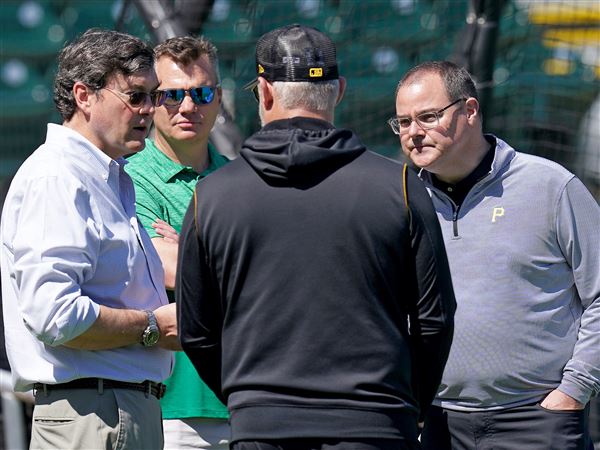Here a quack, there a quack, everywhere a quack quack.
There are ducks everywhere in Pittsburgh these days, from an overgrown bath toy swimming the shores of the Allegheny to mini-varieties for sale all over the city.
And while the Pittsburgh duck invasion is a recent phenomenon, rubber ducks have treaded American waters for quite some time.
Rubber ducks were first manufactured in New York City around the 1860s, around the time of the emergence of the rubber industry, said Craig Wolfe, chief executive officer of the CelebriDucks rubber duck company, headquartered in California, and amateur rubber duck historian.
"They didn't just do ducks -- They did all sorts of animals," said Mr. Wolfe. "But the rubber duck took off."
In 1933, a vice president at Seiberling Latex Co. was watching Walt Disney's Three Little Pigs in an Ohio theater and got the idea to license Disney characters for rubber ducks.
Donald Duck, who debuted as a Disney character the following year, became a natural fit for a licensed rubber duck. Donald Duck bath toys became extremely popular, with hundreds of different varieties manufactured.
And the duck tales don't end there.
A "pop-up" exhibit at the ToonSeum cartoon museum Downtown is exploring "iconic quackers" in both rubber and cartoon form, with Donald Duck production cels, background art from Mallard Fillmore and rubber ducks of all varieties. Of particular focus will be rubber ducks inspired by celebrities, produced by CelebriDucks.
There is some evidence tying Donald Duck to Pittsburgh, said Joe Wos, executive director of the ToonSeum. Scrooge McDuck, who immigrated at age 13 to make his fortune in America, is thought to be based on Andrew Carnegie, who did the same, Mr. Wos said.
And in an episode of the cartoon "Duck Tales," the location of Duckburg is shown on a map of the United States and lines up precisely with Pittsburgh, he said.
Rubber ducks gained popularity as bath toys in the '50s and '60s and were memorialized in a 1970 "Sesame Street" episode in which Ernie sings sweetly to his rubber duckie. The song not only rose to No. 16 on the Billboard "Hot 100 Singles" chart, but also it further cemented the place of the rubber duck to a whole new generation of children.
The ducks also tell a story of American manufacturing, said Mr. Wolfe, noting that by the 1990s, not a single duck was still made in America. "It's really unusual to see a whole industry grow up in a country and totally leave," he said.
Several years ago, Mr. Wolfe's company started making the ducks in the U.S. again -- the only manufacturer to do so -- in the same New York City factory that once produced Ernie ducks.
Rubber ducks have also made waves in other areas. As detailed in the book "Moby-Duck," by Donovan Hohn, 28,800 bath toys, including rubber ducks, spilled into the north Pacific Ocean in 1992 from a cargo ship container.
The yellow ducks and other bath toys have washed up on shores from Alaska to Maine to Hawaii to Scotland and have helped oceanographers research ocean currents by tracking their movements.
Over the years, the ducks have become a symbol of childhood, of playful fun and of nostalgia. It was those concepts that led Dutch artist Florentijn Hofman to create the duck as an art installation in 2007.
"It's about looking, viewing, seeing things in new ways and being amazed," Mr. Hofman said at a Pittsburgh news conference. "When we are living on one planet, all global waters become your bathtub."
Mr. Hofman's giant rubber duck has traveled the world, from Amsterdam to Australia to its most recent stop in Beijing.
Mr. Hofman's 4-story tall rubber duck debuted here Friday as part of the Pittsburgh International Festival of Firsts, presented by the Pittsburgh Cultural Trust.
The rubber duck has also become a symbol, and a celebration, of whimsy -- a concept which has worked well as a business model for Mr. Wolfe.
His company had one of its first major successes with Allen Iverson ducks -- cornrows and all -- that were given away as a promotion at a Philadelphia 76ers game. His most popular celebrity duck is a Gene Simmons duck, followed by Mr. T and a transvestite Rocky Horror Picture Show duck.
Mr. Wos will be displaying a variety of celebrity rubber ducks at the ToonSeum exhibit, his favorite being Mr. T. He's trying to focus purely on the fun of rubber ducks, no matter their size.
"It doesn't need to bring about world peace; it doesn't need to unite us," he said. "In the end, it's a giant rubber duck, and there's nothing wrong with that."
First Published: September 30, 2013, 8:00 a.m.

















